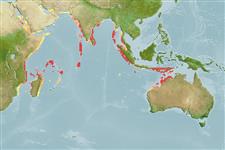>
Gobiiformes (Gobies) >
Gobiidae (Gobies) > Gobiinae
Etymology: Eviota: No etymology given, suggested by Christopher Scharpt: from Latin 'eu' for 'true' and 'iota' for anything very small, in combination 'truly very small' referring to it as being the smallest vertebrate at the time it has benn described by Jenkins (thus, making the suggestion by Scharpt plausible.; mikiae: Named for Miki Tonzuka of Bali, Indonesia, for her assistance with fish collections during the Weh Islands survey (Ref. 44113).
Environment: milieu / climate zone / depth range / distribution range
Écologie
marin récifal; profondeur 6 - 25 m (Ref. 30404). Tropical
Indian Ocean: Seychelles (Amirante Islands), Chagos Archipelago, Maldives, Thailand (Andaman Sea), and Indonesia (Sumatra).
Taille / Poids / Âge
Maturity: Lm ? range ? - ? cm
Max length : 3.5 cm TL mâle / non sexé; (Ref. 30404)
Épines dorsales (Total): 7; Rayons mous dorsaux (Total): 9; Épines anales 1; Rayons mous anaux: 8. Pectoral fin rays simple; spinous dorsal fin moderately elongate in both sexes, second and third rays longest, fifth pelvic fin ray well developed, two-tenths to three-tenths length of fourth ray; cephalic sensory pore system lacking IT and PITO pores, and AITO pore single (except double in smallest paratype) and very small; posterior rays of second dorsal and anal fins elongate, forming a lanceolate shape; preserved specimens generally whitish with dark pigment along base of anal fin, extending along ventral edge of caudal peduncle; small dark spot usually present at lower caudal fin base; nostrils dark and pair of brown spots of variable intensity usually present on top of head, just behind eyes (Ref. 44113).
Inhabits rich coral reef slopes with moderate tidal currents, in small groups on large coral heads (Ref. 30404, 48637).
Life cycle and mating behavior
Maturité | Reproduction | Frai | Œufs | Fécondité | Larves
Allen, G.R., 2001. Description of two new gobies (Eviota, Gobiidae) from Indonesian seas. aqua, J. Ichthyol. Aquat. Biol. 4(4):125-130. (Ref. 44113)
Statut dans la liste rouge de l'IUCN (Ref. 130435)
Menace pour l'homme
Harmless
Utilisations par l'homme
Plus d'informations
Noms communsSynonymesMétabolismePrédateursÉcotoxicologieReproductionMaturitéFraiRassemblement de ponteFéconditéŒufsDéveloppement de l'œuf
RéférencesAquacultureProfil d'aquacultureSouchesGénétiqueElectrophoresesHéritabilitéPathologiesTraitementNutrientsMass conversion
CollaborateursImagesStamps, Coins Misc.SonsCiguateraVitesseType de nageSurface branchialeOtolithesCerveauxVision
Outils
Articles particuliers
Télécharger en XML
Sources Internet
Estimates based on models
Preferred temperature (Ref.
123201): 27 - 29.3, mean 28.4 °C (based on 563 cells).
Phylogenetic diversity index (Ref.
82804): PD
50 = 0.5000 [Uniqueness, from 0.5 = low to 2.0 = high].
Bayesian length-weight: a=0.00708 (0.00333 - 0.01504), b=3.09 (2.92 - 3.26), in cm total length, based on LWR estimates for this (Sub)family-body shape (Ref.
93245).
Niveau trophique (Ref.
69278): 3.1 ±0.3 se; based on size and trophs of closest relatives
Résilience (Ref.
120179): Haut, temps minimum de doublement de population inférieur à 15 mois (Preliminary K or Fecundity.).
Fishing Vulnerability (Ref.
59153): Low vulnerability (10 of 100).
Nutrients (Ref.
124155): Calcium = 335 [145, 854] mg/100g; Iron = 1.37 [0.62, 2.92] mg/100g; Protein = 17.7 [15.6, 19.5] %; Omega3 = 0.102 [0.038, 0.257] g/100g; Selenium = 31.5 [10.7, 85.1] μg/100g; VitaminA = 111 [24, 478] μg/100g; Zinc = 3.59 [2.08, 5.80] mg/100g (wet weight);
